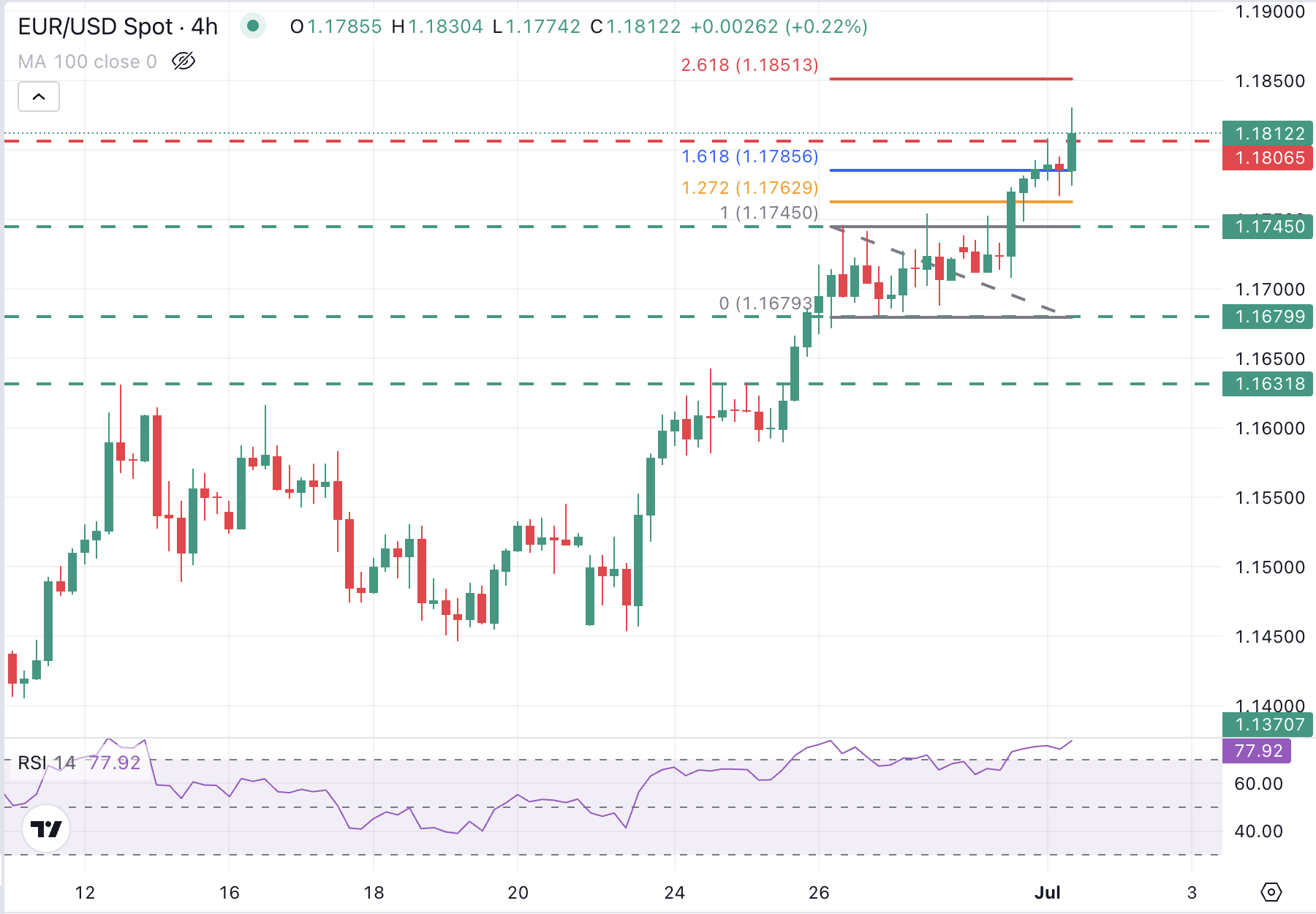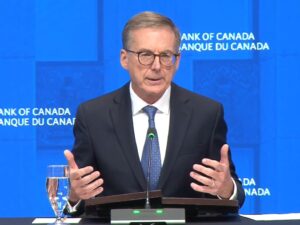EUR/USD consolidated at multi-year highs supported by positive Eurozone figures

- The Euro extends gains for the tenth day, supported by upbeat Eurozone data and a weak US Dollar.
- A mix of trade uncertainty, US debt concerns, and bets on Fed rate cuts is hammering the US Dollar.
- EUR/USD has reached overbought levels at 1.1800, a correction looks likely.
The EUR/USD pair keeps marching higher for the tenth consecutive day. The pair is trading with minor gains above the 1.1800 level at the moment of writing on Tuesday, fuelled by upbeat Eurozone manufacturing figures and German employment data.
The Greenback remains on the defensive, hit by a mix of concerns about the chaotic US trade policy, mounting fears about the country’s fiscal debt, and rising expectations that the Federal Reserve (Fed) will cut interest rates at least twice before the end of the year.
In the trade domain, optimism about Monday’s rare earths deal between the US and China has been offset by US President Donald Trump’s complaints about the discussions with Japan and US Treasury Secretary Scott Bessent’s threats of higher tariffs.
Moreover, uncertainty about Trump’s sweeping tax bill, which is struggling to make its way through the Senate, amid divisions within the republican party about its impact on the US fiscal debt, is adding pressure on the US Dollar.
Another source of pressure for the US Dollar is monetary policy. The president’s continuous pressure on the Fed Chairman Jerome Powell to cut interest rates and the softer US data recently released have prompted investors to ramp up rate cut bets for the second half of the year.
Euro PRICE Today
The table below shows the percentage change of Euro (EUR) against listed major currencies today. Euro was the strongest against the US Dollar.
| USD | EUR | GBP | JPY | CAD | AUD | NZD | CHF | |
|---|---|---|---|---|---|---|---|---|
| USD | -0.20% | -0.35% | -0.76% | -0.03% | -0.14% | -0.39% | -0.58% | |
| EUR | 0.20% | -0.14% | -0.64% | 0.17% | 0.15% | -0.21% | -0.37% | |
| GBP | 0.35% | 0.14% | -0.39% | 0.34% | 0.30% | -0.06% | -0.22% | |
| JPY | 0.76% | 0.64% | 0.39% | 0.78% | 0.62% | 0.36% | 0.19% | |
| CAD | 0.03% | -0.17% | -0.34% | -0.78% | -0.12% | -0.40% | -0.56% | |
| AUD | 0.14% | -0.15% | -0.30% | -0.62% | 0.12% | -0.35% | -0.54% | |
| NZD | 0.39% | 0.21% | 0.06% | -0.36% | 0.40% | 0.35% | -0.17% | |
| CHF | 0.58% | 0.37% | 0.22% | -0.19% | 0.56% | 0.54% | 0.17% |
The heat map shows percentage changes of major currencies against each other. The base currency is picked from the left column, while the quote currency is picked from the top row. For example, if you pick the Euro from the left column and move along the horizontal line to the US Dollar, the percentage change displayed in the box will represent EUR (base)/USD (quote).
Daily digest market movers: The US Dollar extends losses as US fiscal worries return
- With geopolitical tensions in the rearview mirror, concerns about Trump’s Tax Bill, which is expected to add $3.3 trillion to the US fiscal debt load, have returned to the market. Fears of a debt crisis are eroding the idea of US exceptionalism and adding weight to the US Dollar.
- Eurozone manufacturing activity improved somewhat in June, with the PMI edging up to 49.5 from the previous month’s 49.4 reading. These figures are still consistent with a contracting trend, but they beat expectations of a steady 49.4 level and mark their highest level in the last three years.
- German unemployment increased by 11K in June, below the 15K expected, and well below May’s 34K increment. The jobless rate has remained steady at 6.3% against expectations of an increase to 6.4%.
- Preliminary Eurozone Consumer Prices Index (CPI) figures for June have confirmed steady inflation figures with prices ticking up to 2% year-on-year, from 1.9%, and the core inflation steady at 2.3% with both CPI readings flat on the month, broadly meeting market expectations.
- Trump has expressed his frustration about the trade talks with Japan, and Treasury Secretary Bessent warned that the US might introduce higher tariffs on July 9 despite ongoing negotiations.
- Regarding monetary policy, the US president has continued hammering the Fed Chair Powell, affirming that the US rate should be between Japan’s 0.5% and Denmark’s 1.75%. These comments raise questions about the independence of the central bank and undermine the US Dollar’s status as the world’s reserve currency.
- These attacks, along with the soft macroeconomic figures seen recently, have boosted investors’ expectations of Fed rate cuts for the rest of the year. The CME Group’s Fed Watch Tool shows a 20% chance of a rate cut in July, but a rate cut of at least 25 basis points (bps)in September is nearly fully priced.
- Tuesday’s focus will be on the Central Bankers Summit in Sintra, Portugal, where the chiefs of the world’s major central banks will speak about trade, the global economic outlook, and inflation, and might give hints about their rate paths.
- In Europe, the Preliminary Eurozone Consumer Prices Index (CPI) data from June will attract attention. Consumer inflation is expected to have remained steady, following cooler-than-expected CPI readings in Italy and Germany on Monday.
- In the US, the ISM Manufacturing PMI and the JOLTS Job Openings, together with Powell’s speech at the Sinttra summit, are expected to provide further clues about the bank’s rate cut calendar.
EUR/USD reaches overbought levels above 1.1800

EUR/USD trades slightly down, with the 4-hour Relative Strength Index (RSI 14) showing overbought levels as the pair extends above the 1.1800 area. This is often a sign of an upcoming corrective reaction.
On the downside, the previous high at 1.1750 (June 26 and 27 highs), is likely to provide some support to a stronger bearish reaction, ahead of the June 27 low at 1.1680
On the upside, above 1.1800 the 261.8% Fibonacci extension level of the June 26.30 trading range is at 1.1850, a plausible bullish target for today.
German economy FAQs
The German economy has a significant impact on the Euro due to its status as the largest economy within the Eurozone. Germany’s economic performance, its GDP, employment, and inflation, can greatly influence the overall stability and confidence in the Euro. As Germany’s economy strengthens, it can bolster the Euro’s value, while the opposite is true if it weakens. Overall, the German economy plays a crucial role in shaping the Euro’s strength and perception in global markets.
Germany is the largest economy in the Eurozone and therefore an influential actor in the region. During the Eurozone sovereign debt crisis in 2009-12, Germany was pivotal in setting up various stability funds to bail out debtor countries. It took a leadership role in the implementation of the ‘Fiscal Compact’ following the crisis – a set of more stringent rules to manage member states’ finances and punish ‘debt sinners’. Germany spearheaded a culture of ‘Financial Stability’ and the German economic model has been widely used as a blueprint for economic growth by fellow Eurozone members.
Bunds are bonds issued by the German government. Like all bonds they pay holders a regular interest payment, or coupon, followed by the full value of the loan, or principal, at maturity. Because Germany has the largest economy in the Eurozone, Bunds are used as a benchmark for other European government bonds. Long-term Bunds are viewed as a solid, risk-free investment as they are backed by the full faith and credit of the German nation. For this reason they are treated as a safe-haven by investors – gaining in value in times of crisis, whilst falling during periods of prosperity.
German Bund Yields measure the annual return an investor can expect from holding German government bonds, or Bunds. Like other bonds, Bunds pay holders interest at regular intervals, called the ‘coupon’, followed by the full value of the bond at maturity. Whilst the coupon is fixed, the Yield varies as it takes into account changes in the bond’s price, and it is therefore considered a more accurate reflection of return. A decline in the bund’s price raises the coupon as a percentage of the loan, resulting in a higher Yield and vice versa for a rise. This explains why Bund Yields move inversely to prices.
The Bundesbank is the central bank of Germany. It plays a key role in implementing monetary policy within Germany, and central banks in the region more broadly. Its goal is price stability, or keeping inflation low and predictable. It is responsible for ensuring the smooth operation of payment systems in Germany and participates in the oversight of financial institutions. The Bundesbank has a reputation for being conservative, prioritizing the fight against inflation over economic growth. It has been influential in the setup and policy of the European Central Bank (ECB).




